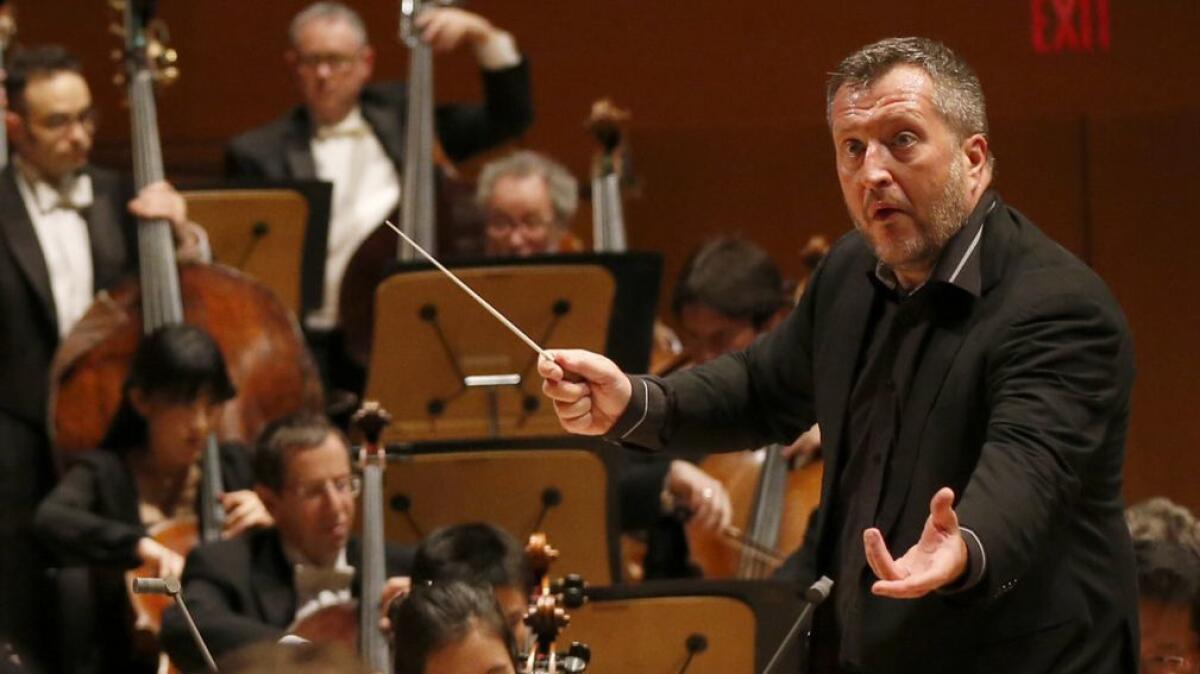Thomas Adès descends to hell and back in his showstopping ballet ‘Inferno’

- Share via
When Thomas Adès refers to “Inferno,” his new orchestral work for ballet, as a showstopper, it’s not hyperbole.
At its concert premiere via the L.A. Philharmonic at Walt Disney Concert Hall in May, the work elicited huge, spontaneous applause following its penultimate section. The piece wasn’t over, but those in the audience couldn’t help themselves. A few even jumped to their feet.
“I take no credit for it, because Gustavo [Dudamel] is brilliant,” the 48-year-old British composer says, suggesting that it was the Phil’s performance as much as his score to which the audience responded. “But to have a showstopper, that is very exciting. … And this was a showstopper with a standing ovation attached, which was something I’ve never seen before. I’m absolutely not boasting, but I’m quite excited to see what happens when we throw 33 dancers into that as well.”
Los Angeles audiences will get the chance to see exactly what happens Friday and Saturday at the Music Center’s Dorothy Chandler Pavilion when “Inferno” is resurrected, this time with choreography by Wayne McGregor, performed by Company Wayne McGregor. The L.A. Phil’s players will again conjure ecstatic hellfire from their instruments, conducted this time by Adès himself. Rounding out the work’s stellar creative team is artist Tacita Dean, who designed the set and costumes.
Can artificial intelligence become a choreographer? Wayne McGregor brings AI to L.A. »
It was a previous collaboration with McGregor, Adès says, that inspired him to compose a work specifically intended as an evening-length dance piece. In 2010, the British choreographer chose Adès’ 2005 violin concerto “Concentric Paths” as the musical backdrop for his piece “Outlier.” (That piece, along with a new work McGregor has choreographed to accompany Adès’ “In Seven Days,” will be performed alongside “Inferno” at the Music Center. Violinist Leila Josefowicz and pianist Kirill Gerstein join as soloists.)
When, in 2015, “Outlier” was presented alongside choreographed versions of several other Adès works, the composer began to think seriously about composing music specifically for dance. “That evening was very interesting from my point of view,” he says. “It made me think perhaps I should actually compose a ballet; you know, sit down and write music I’m conceiving as dance music from the word go. I hadn’t done that before. And it was Wayne who was the first to say, ‘Would you like to do it with me?’”
“I quite often collaborate with the dead.”
— Thomas Adès
Adès had always wanted to tackle Dante’s “Divine Comedy” musically, and this seemed the perfect project for it. On the opera stage, the composer has already reinterpreted a Shakespeare play (“The Tempest”) and a classic film by Luis Buñuel (“The Exterminating Angel”), but Dante’s epic tale was never going to work as an opera, he says.
“But it being a dance, of course, sets one in a way free from certain of the local details of the piece. All the different characters, which are complete when you’re reading it, you can’t dance or sing every single one of them,” the composer says.
To solve this problem, Adès created his own scenario for the work, distilling Dante’s many characters into what he calls essential archetypes: “Like in the ‘Nutcracker Suite,’ you have the coffee and the chocolates and the Sugar Plum Fairy. In my ballet, you have the selfish and the deviants and the suicidal.”
A sizzling, crackling whip of a piece, Adès’ “Inferno” is a 45-minute, continuously performed (except in the case of a spontaneous standing ovation) series of 13 movements or scenes.
“It’s really kind of a thumbnail map of the journey through ‘Inferno,’” Adès says. “I mean, we had to leave an awful lot out, but it is all in there in one form or another if you dig a bit.”
It is also just the beginning. Adès is currently working on 45 additional minutes of music based on Dante’s “Purgatorio” and “Paradiso.” In 2020, he, Dean and McGregor will present all three sections as an evening-length work at the Royal Opera House in London.
But before audiences can ascend into heaven with this creative team, they must first spend time in hell, a delicious, riotous place to be in this case.
“We’re not going to have little people dressed in red with pitchforks jumping ’round,” the composer says, describing the way in which he connects with Dean’s black-and-white design.
The composer says he is drawn to Dean’s use of “old” mediums like drawing, photography and film. It reminds him of the way in which he drew on classic source material while composing “Inferno” — in his case, the music of Franz Liszt, who himself wrote a piano sonata and a symphony inspired by the “Divine Comedy.”
“I quite often collaborate with the dead,” Adès says. “And Liszt really owns hell and the demoniacal. I looked at what he’d done, and those sounds that arose in him were still completely live cultures. I could put them in passages and new things would happen. So the music in ‘Inferno’ moves from absolutely 100% me, to 100% Liszt and every gradation in between. I wanted to have this strange feeling that you were almost falling down into the past.”
The composer identifies the same kind of looking back in Dean’s design. It’s an example, he says, of McGregor’s genius in choreographing an artistic collaboration that feels natural and organic.
“I didn’t know Tacita before,” he says. “But I love her works. When this all comes together at the Music Center, it’s going to be a thriller.”
“Adès & McGregor: A Dance Collaboration”
When: 7:30 p.m. Friday-Saturday
Where: Dorothy Chandler Pavilion, 135 N. Grand Avenue
Tickets: $34-$138
Info: www.musiccenter.org
More to Read
The biggest entertainment stories
Get our big stories about Hollywood, film, television, music, arts, culture and more right in your inbox as soon as they publish.
You may occasionally receive promotional content from the Los Angeles Times.










